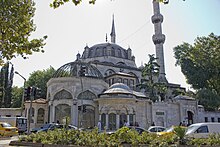Yeni Valide Mosque
The Yeni Valide Mosque ( Turkish Yeni Valide Camii ; Ottoman Valide-i Cedid Camii ) is an Ottoman mosque from the 18th century in the Istanbul district of Üsküdar .
history
The foundation stone was laid on September 7, 1708, and according to the inscription it was completed in 1710. The church was built by order of Sultan Ahmed III. in honor of his mother Emetullah . Valide means mother (cf. Valide Sultan ). The name “New Valide Mosque” ( Yeni and cedid mean “new”) was given to the complex to distinguish it from the other mosques for the sultan's mothers. The architect was Mehmet Ağa from Kayseri , a student of Sinan . However, according to Tülay Sezgin Orman, this is not completely certain.
Between 2013 and 2015, the entire complex was extensively renovated and restored.
architecture
In addition to the mosque, the complex also consists of a soup kitchen , a small bazaar, a primary school, the mausoleum of Emetullah, an inner courtyard with Şadirvan , a muvakkithane added in the 19th century and offices. The building is considered typical of the classical Ottoman period. The main building was erected on a rectangular floor plan and is covered by a dome and four semi-domes. The mosque has two minarets with two balconies each . The calligraphy above the door of the forecourt ( avlu ) and the throne verse surrounding the interior of the dome were created by Hezarfen Mehmet Efendi . The marble comes from an island in the Marmara Sea .
The mosque has an octagonal floor plan and a central dome with 24 windows. The model for the plans was the Rüstem Pascha mosque , the modifications, such as z. B. the corner domes, but give it a more classic look. The mosque is an early example of the 18th century architectural style with taller and narrower domes. The cross vault above the entrance area was used for the first time in this mosque: instead of the usual five domes above the portico , as was common in Ottoman mosques, a cross vault was created for the main aisle and cloister vaults for the side aisles . The interior of the mosque is decorated with stone carvings, including muqarnas with floral motifs and faiences with floral designs .
The windows of the mosque are designed with pointed and round arches: The windows below the domes are designed with pointed arches, which means that the domes appear more elongated. The windows of the domes are made with round arches. The entrance area and the octagonal Şadirvan in the inner courtyard are richly decorated. The doorway of the sultan's mother in the southeast corner of the building is open at the top and is spanned by a dome made of richly decorated latticework. The school is located at the north entrance of the complex.
gallery
Mausoleum of the sultan's mother Emetullah
literature
- Aptullah Kuran: Sinan: The Grand Old Master of Ottoman Architecture . Institute of Turkish Studies, Washington DC 1987. p. 242
- Doğan Kuban: Ottoman Architecture . Antique Collectors' Club, Woodbridge 2010, pp. 384-386
- Müşfika Akbulut: Üsküdar Yeni Camii ve Külliyesi . Diploma thesis in 2003 at the Institute for Social Sciences at Marmara Üniversitesi
Web links
- The Yeni Valide Mosque at Archnet
Individual evidence
- ^ Godfrey Goodwin: A History of Ottoman Architecture . Thames and Hudson, London 1971, ISBN 0-500-27429-0 , p. 365
- ↑ Tülay Sezgin Orman in: Türkiye Diyanet Vakfı İslâm Ansiklopedisi , sv YENİ VÂLİDE KÜLLİYESİ.
- ↑ İstanbul Üsküdar Yeni Valide Camii ve Külliyesi , Avunduk Architects, accessed on April 21, 2018 (with drawings and photos)
- ↑ İstanbul'da Camileri . AS Book, Istanbul, pp. 230-232
Coordinates: 41 ° 1 ′ 29.2 ″ N , 29 ° 0 ′ 54.4 ″ E





